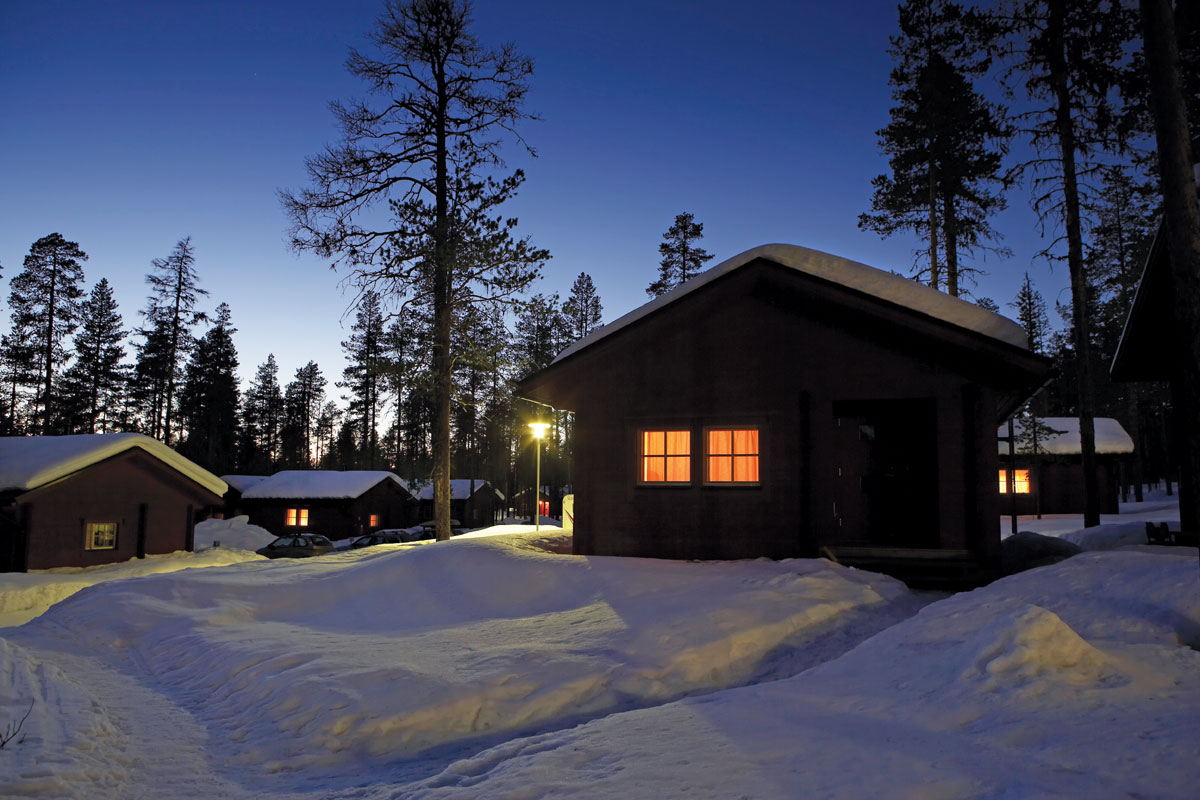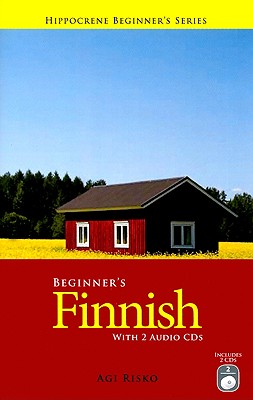When I first saw this book sitting on a shelf at the used book store, I was pretty skeptical as to whether it was even worth my time to look at. First of all, it’s published by Hippocrene, a publisher known for its assortment of mediocre introductory language texts, and secondly, because one typically wouldn’t expect a high quality textbook for a less-studied language like Finnish. Once I got my hands on the book, however, I could tell just by a quick flip through the pages that this book was more than met the eye.
Starting with a look at the back of the book, one can already tell that this isn’t your typical gimmicky language text, as it gives a satisfactory explanation of the goals of the course, its content, and the background of the author. We learn that Agi Risko, a native speaker of Hungarian (I trust language books written by non-natives more), has quite an impressive linguistic and teaching background that more than qualifies her as an author in this field. It says that the course is for anyone who wants to learn the basics of Finnish, but if I had to give my personal evaluation, I would say it’s best suited for adult learners or college students inside or outside of a classroom environment.
I truly love introductions like the one found in this book. First of all, it addresses the reader directly, instead of resorting to the cold, academic style of referring to both the reader and author(s) in the third-person (e.g. “The authors of this text wrote this with the intent that the students will find…). It also concisely describes all the essentials about where it is spoken, and who it is spoken by, which I really like to see in any introductory text. The author also includes a breakdown of the book’s format and how she suggests that you use it to learn the language. Unfortunately, the pronunciation guide is quite minimal, as there are no detailed explanations or examples of words using the sounds of the languages, but I have to admit that it is still better than many texts, as it includes both English parallels and IPA (International Phonetic Alphabet). With that said, the audio CD provides a native speaker reciting each sound of the alphabet individually along with an example word using the sound, which is one of the best ways to learn anyway.
The format of the book is nothing new and exciting, but it faithfully follows the winning formula that has been used for years in teaching with the audio-lingual method. Each lesson contains the following:
· A dialogue (relatively long, compared to other beginner texts)
· A parallel English translation of the dialogue text on the opposing page
· Vocabulary from the dialogue listed in order of its appearance (my personal favorite)
· Useful expressions
· Grammar
· Exercises
Another thing I like about this book is that it provides both the English and the Finnish for the titles of each section. I like this because it allows you to learn the words for things like “dialogue”, “lesson”, “grammar”, etc. fairly easily after a lot of exposure, without intimidating you, as some texts do, by not providing the English equivalent next to it.
From the first lesson, the dialogues are long and somewhat challenging. The book follows the every day adventures of two American students studying in Finland. I am definitely a fan of any language text that makes an effort to use specific characters throughout the book so that there is a feeling of continuity. There aren’t really any explanations of the content of the dialogues, so you will have to piece together your understanding of them from the vocabulary list, the grammar explanations and comparing with the English translation. As far as I can tell, each vocabulary section following the dialogues gives a complete list of all the new words presented in the dialogue, though I haven’t yet done an extensive test on this to see if that’s 100% true. The “useful expressions” section in each lesson provides around 10 phrases or bits of speech to help you out with expressing yourself. They are definitely useful, but there isn’t any particular systematic order to their presentation.
I must say I am quite impressed with the themes for each lesson. Instead of following what most introductory texts do, boring you with rare vocabulary for complicated situations you will likely rarely find yourself in as a student of language (e.g. checking in with customs, ordering a newspaper on the airplane, buying different cuts of meat, pointing out different animals at the zoo), each lesson is centered around some kind of casual situation between friends and acquaintances. Some examples from this book are “Getting to know each other”, “What did you do during the weekend?”, “In someone’s apartment”. This is exactly how I would suggest any potential language textbook author set up their dialogues – certainly a strong point of this book. As for how interesting or natural the dialogues will be to the learner, that’s harder to say. I can’t really judge how natural the dialogues sound in Finnish, as my level of Finnish is extremely low, but as far as I can tell from looking at the English translations, they don’t seem overly contrived. Whether students will find the dialogues interesting or not really depends on the person. I really like the dialogues in this book because they are just normal every day interactions with normal people. There are interesting little tid-bits about Finnish culture thrown in throughout the dialogues, but those who want to see thrilling stories, profound commentaries, or laugh-out-loud humor certainly won’t find it here.

As I suggested above, some students may find the book to be overly challenging. The way the book starts off with long, complicated dialogues from the very beginning can definitely prove intimidating, even to those who have a bit of experience learning languages. I think it’s definitely possible to work beyond this by decoding each phrase from the dialogue little by little, but it’s understandable if some students would be put off by the lack of a more gradual introduction. Each new lesson introduces about one and a half pages of new words, which is a relatively large amount for beginners, but I think it is manageable for patient and motivated students.
Each dialogue has accompanying audio, and I would say I am content with the quality. The speakers do not sound amazingly natural or enthusiastic, and it is fairly obvious that they are reading their lines directly from the script, but they aren't completely lifeless either. All the speakers seem to maintain a normal rate of speech, which is definitely a plus, compared to many introductory courses that think they’re doing students a favor by having all the recordings spoken extremely slowly. There are four audio tracks associated with each lesson – one with the dialogue at normal speed, one called “dialogue for repetition”, playing the dialogue at a slower speed with spaces to repeat, a track reading all the new vocabulary words one by one (allowing for more repetition practice), and finally one with someone reading off all the useful expressions. The audio is high quality, and I really think they did a great job in including these four different tracks for each lesson in the book.
"All the speakers seem to maintain a normal rate of speech, which is definitely a plus, compared to many introductory courses that think they’re doing students a favor by having all the recordings spoken extremely slowly."
As for the grammar section, I find it to be sufficient, but some students might feel like there is something missing. The language could be considered dry, and the explanations definitely assume that students have a basic understanding of grammatical nomenclature. Personally, I find the explanations of grammar terse, yet not lacking by any means. The author generally provides two to four examples of each point to illustrate the aspects of Finnish grammar she introduces, which is certainly not abundant or as thorough as some books might be, but it seems to be enough as to not leave students confused with how things work.
At the end of each lesson there is a section providing a few exercises based upon the content of the lesson. The exercises vary greatly from chapter to chapter, but some examples are: change the sentence into past tense, negate the following sentence, change these words to this case, etc. Some of them are silly, some of them are useful, but I think for the most part the author does a good job in helping students reinforce or test their Finnish knowledge after completing a lesson. It is important to note that there is a thorough key to the exercises in the back of the book. For exercises that could have multiple answers it doesn’t provide example answers, but at least tells you “Answers will vary”.
At the end of the book there are English-Finnish and Finnish-English glossaries. Although I didn’t do a comprehensive check, I have already noticed that you simply aren’t going to find every vocabulary item appearing in the lessons present in the glossaries. Part of this can be attributed to the endings and morphological changes that can affect Finnish words, and I think part of it is simple oversight. In any case, it should be well understood that one is going to need a dictionary to reference any terms you can’t find the definition for – this should be easy enough considering that there are many dictionaries available for free on the internet.
Overall, I am very pleased with this book. Its content and format is superior to the vast majority of introductory language texts for any language, and it also has great audio to go with it, not to mention minor details like its visually appealing font and layout. I rate it highly recommended and I think it is probably one of the best resources available for someone looking to start learning Finnish.
For teachers: Students will be challenged by the length of the dialogues. Try breaking them down into smaller portions, perhaps even creating multiple mini-dialogues using the sentences from the lesson. This will help your students feel like they are progressing more quickly, as well as giving them a great boost of confidence when they find they can understand the whole dialogue from beginning to end once it is all put together.
For students: With this text, patience is key. I would suggest making your own word lists on a separate piece of paper while you work your way through the dialogues. This will save you the trouble of flipping back and forth between the pages, as well as the annoyance of having to sort through words you already know.





